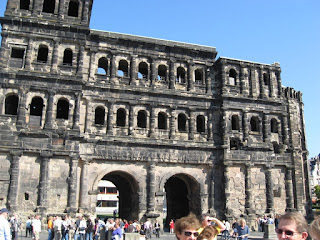
From the first time I heard of this place I wanted to go visit it. Trier lies near the border with Luxemburg in the beautiful Mosel Valley. We left Frankfurt on a gorgeous Saturday morning to head west for approximately two hours soaking in the beautiful German landscape. As we arrived in Trier we knew we were not the only people interested in this place, judging by the entourage of tour buses that preceeded us. Once we got our bearings, we went to the tourist information center adjacent to a magnificent Roman ruin known as Porta Nigra. This represents the last of four gates that with its impressive walls four miles in length which encompassed a city of 80,000 people. The city was founded in 17 B.C. by Augustus and continued to be occupied by the Romans as one of their capitals for 400 years. For nearly three centuries, the Emperors of Rome made this their primary residence and staging point for the conquest of the troublesome Germanic tribes.

At the same time as St Peters Basicillica was being contructed in Rome, a comparable church also called St. Peters was under construction in Trier. The dimensions of this church were enormous. It was designed to accommodate 8000 people and encompassed several city blocks. Only a small portion still remains to which additions were added in the 4th, 12th and 17th centuries. Up until the 3rd century, Christians were persecuted. Under an edict from Constantine, at the bequest of his mother-i-law, the persecution stopped and Christianity started to take hold. This is the oldest church in Germany.
Interesting archeological findings have estalished the use of baptismal fonts where baptisms took place by immersion. Powerful bishops took it upon themselves to relinquish the need for immersion, adopting the much simpler practice of sprinkling with water. Ancient relics from the 3rd century are kept in this church and pilgramages occur every decade or so when visitors from all over the world come to view them.
This city has gone to considerable expense to maintain the historical landmarks. Although the walls are gone, their materials were used for centuries to construct other structures.
In the 3rd century, elaborate Roman baths were constructed with a labyrinth of tunnels and excavations to accommodate the voluminous amounts of water required to feed the hot, warm and cool pools in the complex. No geothermal energy here! All water was heated by a series of wood burning furnaces maintained by slaves under what must have been oppressive conditions. The construction, design and shear proportions of the baths testified to the ingenuity and wealth of the Roman occupants. Ironically, the baths were never used. Upon completion the reigning emperor decided to return to Rome, leaving the baths untested.
An interesting story surrounds the rivalry that existed between a powerful archbishop who later occupied the city as spirtual leader, political powerhouse and its most affluent citizen and the upstart Protestant Church. Two churches and their respective congregations made for somewhat friendly challenges utilizing design features on their churchs as symbols of their competitive positions as each vied for dominance. I will leave that story to be told elsewhere.
We concluded our day in a vibrant marketplace, taking in sights and sounds of the bustling city center. An assortment of entertainment was always within sight or earshot. We had a brass band serenading the tourists and shoppers and mimes amusing us with their antics. The aroma of German cuisine finally got the better of us and we indulged ourselves with some local fare to top a great day.

Lovin the history and the pictures. I especially like to hear about the lifestyle. Going to be a great history lesson for me while you are away. So cool!
ReplyDeleteHow are you finding language issues - I imagine things are predominantly english, no?
ReplyDeleteJared
What an awesome adventure. I love all the history. Good luck and have fun in Germany.
ReplyDeleteLove, Koe
English, not so much. The Germans have yet to maximize the tourist potential of their country. Multiple language venues are few and far between. I think they have some tremendous opportunities, but they fall outside the normal tourist circuit because they either are not aware or they are maintaining a misguided sense of loyalty to their language, or don't feel a need.
ReplyDeleteWhen Koe and I went to Europe with Ricks College we went to the Mossel Valley. We stayed in an courious bed and breakfast where there were about 20 different stairways. Great memories. I would love to take my family to Germany and Switzerland one day. It was one of my favorite stops. So gorgeous! So glad to see all is well. Mom mentioned that you met a relative of ours. Small world in an LDS world!
ReplyDeleteSummer Hatch